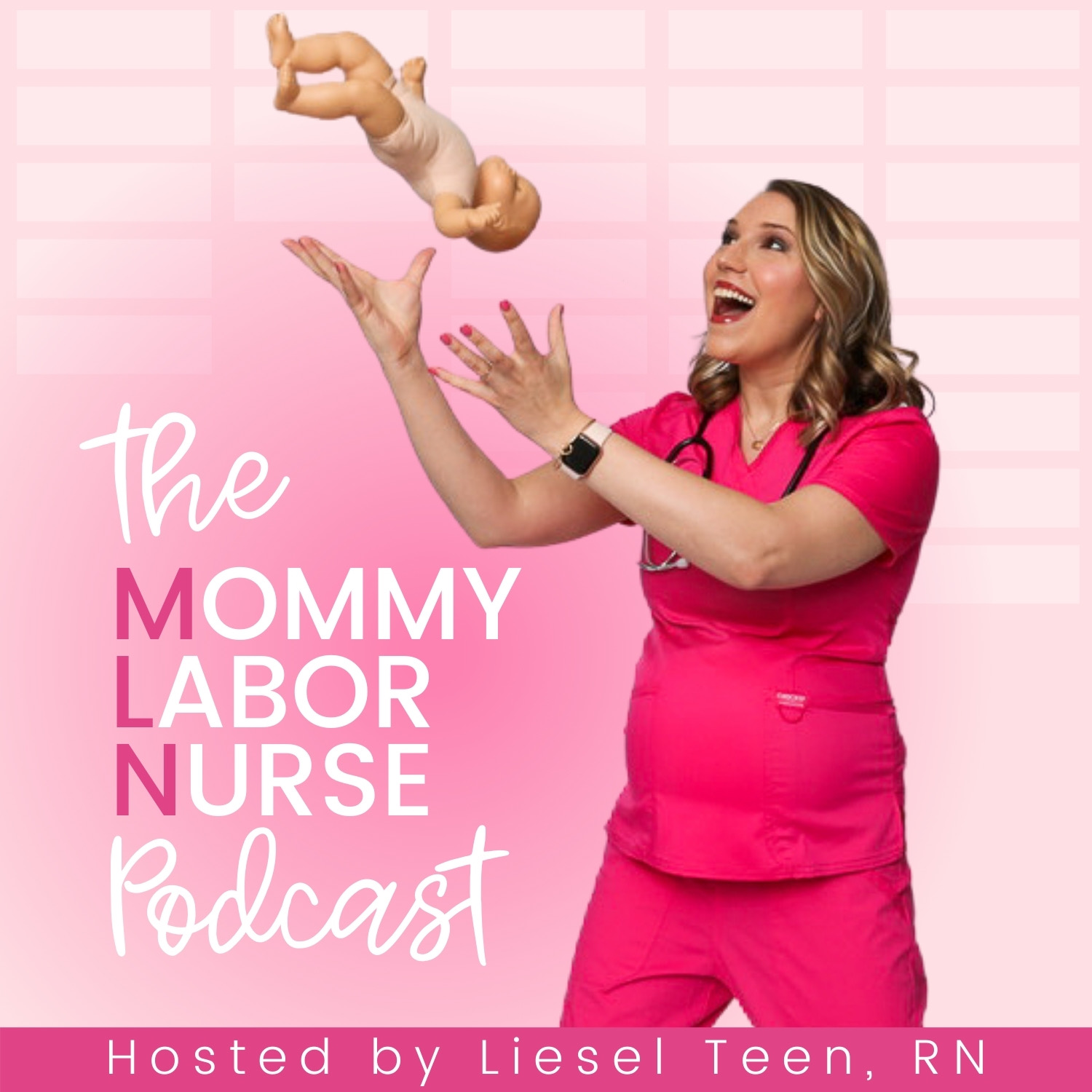This week on The Mommy Labor Nurse podcast I had the opportunity to chat with Lindsey Shipley from Lactation Link. This is actually episode one of a two-part series where we address some labor and delivery terms and other terminology surrounding pregnancy, birth, and breastfeeding!
Like me, Lindsey is an RN with a background in L&D and childbirth education, but she’s also an IBCLC and focuses her online educating platform around breastfeeding. The two of us teamed up to discuss and educate on common terminology that’s just not that commonly understood!
In part one, we focused on labor terms, and then next week you can tune in to hear us dissect terminology on the breastfeeding and postpartum side. This was a really fun episode, and one that I think will be SUPER informative for all the pregnant mamas out there. So without further ado, let’s take a look at what we covered:
- EFM (external fetal monitoring) vs internal monitoring (IUPC and FSE) (14:35)
- Leopold maneuvers (17:07)
- Talking about the cervix and cervical ripening methods
- PPROM/PROM/SROM/AROM
- Cervical terms and cervical checks
- Labor and deliver specific terms
- After that, a few other things we touch on related to L&D included:
- Wrapping up
- Want to erase anxiety and actually feel excited about birth?
- Have an even better birth!
- About Lindsey
- About our sponsor: Motif Medical’s Luna Pump
EFM (external fetal monitoring) vs internal monitoring (IUPC and FSE) (14:35)
After we do a bit of a meet and greet, and hear about Lindsey and her background we dive right into our first term, EFM, which stands for external fetal monitoring. Lindsey took this one and explained what external fetal monitoring is and how you can expect it to go down.
Then, it only made sense to discuss INTERNAL monitoring too – which is a little less common, and most often comes into play if we see distress with baby or what we call decelerations. Once we got talking about these things, other terms instantly started to come up. This included FHR and FFN.
It actually perfectly illustrates the way that medical “lingo” can kind of take on a life of its own.
Leopold maneuvers (17:07)
This is actually a really cool thing that your L&D nurse, OB, or midwife might do during your birth. They can actually feel the outside of your belly when you’re in different positions throughout your labor to figure out how baby is positioned.
It’s super helpful because it gives us a clue as to how baby is responding to various positions during labor, and allows your nurse or provider to make position change suggestions to YOU to help get baby to move down into the birth canal.
This is one of those things that often happens, but mamas don’t realize it’s happening and especially don’t know what it’s called, so I was happy to include it on this list!
Talking about the cervix and cervical ripening methods
In this part of the episode, we focus on cervix-related terminology because they are terms that come up for most mamas in the final weeks before birth (or when you check-in!). And they might be even more relevant for my mamas that have planned inductions.
Here’s what we went over:
- Favorable vs. unfavorable cervix
- Cervical ripening
- Cytotec induction vs. Cervidil induction
- Foley bulbs
PPROM/PROM/SROM/AROM
Once we made our way through the induction and cervical terminology, we switched gears to discuss terminology related to your bag of waters! Here’s a bit from the episode,
“All of these have to do with your bag of waters or your membranes. Okay, so that’s just kind of the cushion that baby lives in – the water, for that whole 9/10 months that they’re cooking. But the scenarios for how that bag of water breaks can get kind of confusing.”
- Preterm Premature Rupture of Membranes (PPROM) is when your water breaks before you even go into labor, and it’s earlier than 37 weeks
- Premature Rupture of Membranes (PROM) is when you water breaks before labor and you are at least 37 weeks
- Spontaneous Rupture of Membranes (SROM) means that your bag of waters broke on it’s own
- Artificial Rupture of Membranes (AROM) is when your provider ruptures your membranes (breaks your water) as a way to speed up labor, or potentially get labor going
Cervical terms and cervical checks
In this part of the episode, Lindsey and I switch roles and I do more of the terminology explanations. We quickly go over IOL (induction of labor) and then dive into terminology related to cervical checks.
Here are some of the things you’ll learn more about when you listen in:
- Dilation
- Effacement
- Station
- Anterior vs. posterior cervixes
During the episode, we unpack all of these terms, and together Lindsey and I came up with some great visual metaphors that will really help you understand what these things mean, so be sure to tune in!
Labor and deliver specific terms
The next category of terms we dive into are L&D specific. Everything from preterm labor to what unmedicated vs. medicated birth even means. It was a great opportunity for me to really unpack what the term “natural birth” is, and what people mean when they say they’re hoping to go “unmedicated” too.
At the end of the day, most people use those terms to mean birthing without an epidural. Mamas that use nitrous, or a bit of IV pain medication often still consider their births unmedicated or natural because they avoided an epidural.
This is one of those interesting birth culture things that I always like to dive into because it’s something that you guys ask me about over on IG ALL the time. So definitely tune in to hear more about this often controversial terminology.
After that, a few other things we touch on related to L&D included:
- Bulging bag of water (BBOW)
- VBAC
- TOLAC
- Transition and the stages of labor
- Failure to progress (and the negativity of terms like this!)
- Laboring down/Rest and descend
Wrapping up
Mama, this is an episode that is just filled to the BRIM with so much info that will help you have a more informed birth. It was hard for me to pack it all into the show notes without this being a full blown article!
Knowing about all of this terminology ahead of time will prepare you to advocate and ask meaningful questions when you’re actually giving birth. And don’t forget – next week is part 2 where we dive into postpartum and breastfeeding. Can’t wait to see you then!
Want to erase anxiety and actually feel excited about birth?
Get instant access to my FREE Birth Workshop to learn tons of pain-coping strategies and actionable tips today!
Have an even better birth!
CLICK HERE to learn more about our online birth classes that will help you feel prepared and in control – no matter how you deliver.
And be sure to follow @mommy.labornurse on Instagram to join our community of over half a million for education, tips, and solidarity on all things pregnancy, birth, and postpartum!
About Lindsey

Lindsey Shipley is an RN, Childbirth Educator, International Board Certified Lactation Consultant, cancer survivor, and mom of 3. After being a labor and delivery RN for 5 years, Lindsey saw too many moms feel scared and unsure when it came to breastfeeding. She overheard lots of differing opinions and conversations on “the right way” or “the best way” to breastfeed. It’s no wonder moms can feel overwhelmed and unsure. Lindsey set out to change all that with Lactation Link!
When her second baby was six weeks old, she was diagnosed with cancer and went through two years of treatment. With education and support, she was able to reach her own breastfeeding goals despite facing that challenge. That experience made her passionate about creating a breastfeeding resource families knew they could trust when they experienced challenges of their own. Through the Lactation Link online classes and support forum, she has created reliable, research-based information that is also easily accessible.
She is based in Utah, but her customer base is everywhere because of her online classes and e-consults.
You can connect with her:
- On Instagram: @lactationlink
- Over at her website: Lactation Link
- In her FREE webinar: 3 Secrets to Creating a Great Milk Supply
About our sponsor: Motif Medical’s Luna Pump
Are you in search of the perfect pump for the breastfeeding days? The Motif Medical Luna is a powerful new breast pump, built for modern motherhood and covered by insurance. Now battery-powered to give you more freedom and flexibility, Luna’s rechargeable battery lasts over 2 hours.
It’s also got a super simple set-up and easy customization option so you can quickly find out what works best for you and your baby. The Luna features a backlit LCD screen, built-in night light, closed system, quiet motor, and auto shut-off, it’s also super light-weight- weighing in at just 2 lbs.
But beyond the features and ease of use, The Luna works! In a third-party study, 5 out of 6 moms reported more milk in less time with Luna—one major reason why 90% surveyed preferred the Luna over their current pump.
As a pumping mama, I personally used and LOVED my Luna pump. The massage and expression mode provides full control and maximum comfort. These modes stimulate letdown by mimicking your baby’s natural nursing pattern and expresses milk from the breast with high efficiency.
To learn more about The Luna and order one for your breastfeeding and pumping journey, head on over to motifmedical.com. Sophisticated, strong, soothing, and covered by insurance – get ready to make your pumping days a little bit easier with The Luna. To learn more about The Luna and order one for your breastfeeding and pumping journey, head on over to motifmedical.com.






